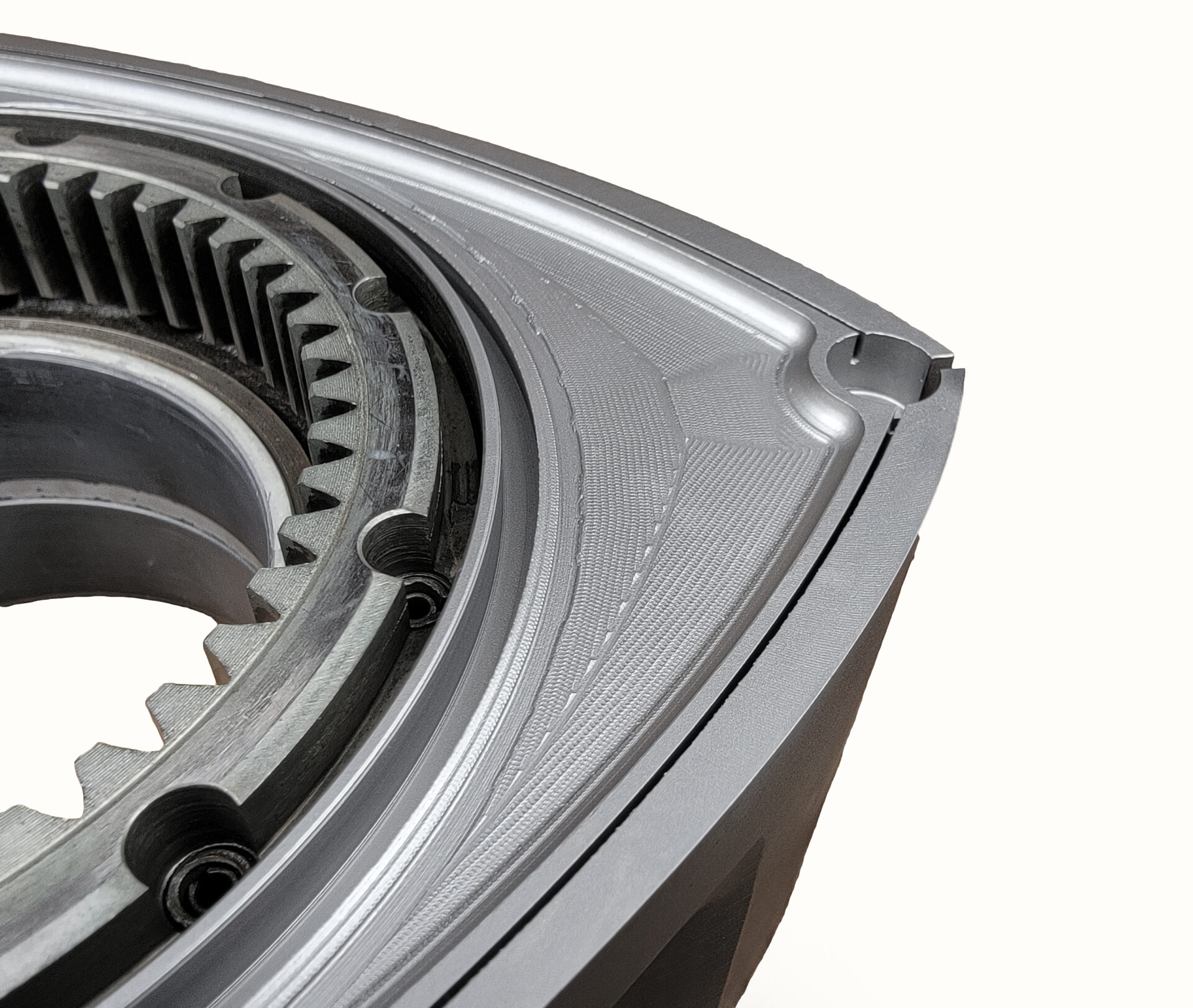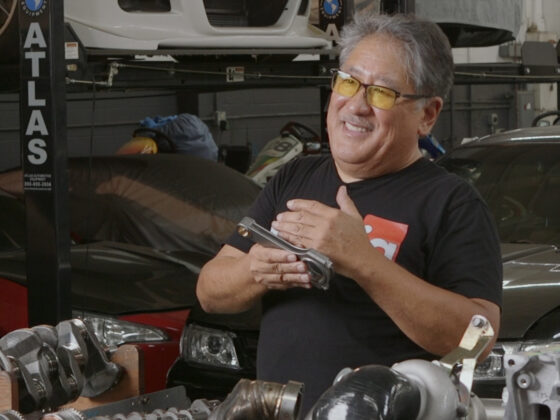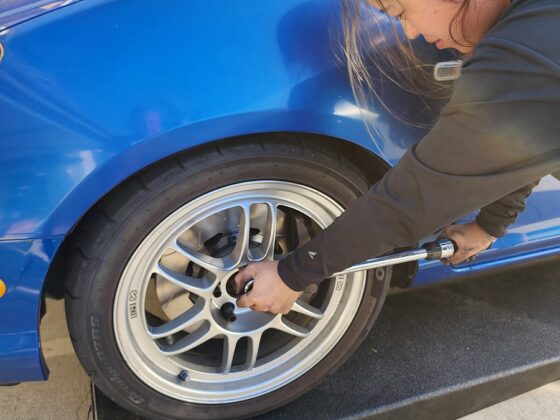 Some engine builders do an additional tip clearance which involves grinding down the tip of the rotor at an angle to provide for even more clearance at the furthest end of the rotor. This will be a source of a lot of controversy and disagreement, but our engine builder Abel Ibarra does not recommend doing this when the engine is “built correctly” by stabilizing and stiffening the block with proper doweling and studding. But let’s look into this with some math.
Some engine builders do an additional tip clearance which involves grinding down the tip of the rotor at an angle to provide for even more clearance at the furthest end of the rotor. This will be a source of a lot of controversy and disagreement, but our engine builder Abel Ibarra does not recommend doing this when the engine is “built correctly” by stabilizing and stiffening the block with proper doweling and studding. But let’s look into this with some math.
 The center of the corner seals on a 13B rotary sit 2.647” from the center of the rotor, which is only 1.191” further out than the radius of the rotor bearing itself. Since rotor bearings have a clearance of 0.0015-0.0020”, the rotor can only wobble 0.0393515-degrees before the bearing hits the e-shaft. This translates to only 0.0018” of movement at the center of the corner seal, or just under two-thousandth of an inch of additional movement.
The center of the corner seals on a 13B rotary sit 2.647” from the center of the rotor, which is only 1.191” further out than the radius of the rotor bearing itself. Since rotor bearings have a clearance of 0.0015-0.0020”, the rotor can only wobble 0.0393515-degrees before the bearing hits the e-shaft. This translates to only 0.0018” of movement at the center of the corner seal, or just under two-thousandth of an inch of additional movement.
With anywhere from 15-20 thousandths of an inch (0.015-0.020”) of static/assembly clearance between the rotor and side housing, there should still be 13-18 thousandths of clearance from the tip of the rotor to the side housing when the rotor is at max deflection. This means that if there is contact, it is actually caused by the housings twisting and flexing, not from the rotor wobbling.
Abel says the right solution is to address the actual problem by stabilizing the block by studding and pinning it properly. The stackable nature of the rotary engine does not lend to an inherently stiff block design that has to deal with the extreme forces of combustion and rotation inside the housings. While this is not a problem at stock power levels; as power increases, the housings and irons start to distort and ‘walk’ as the factory dowels cannot handle these stresses and, causing rotor contact, breaking seals, and leading to engine failures.
According to Abel, tip-clearancing rotors has been a compromised solution that causes a loss of compression and torque, takes away quench, and resulting in less power, efficiency, and a worse running engine. It is widespread implementation has been a “monkey-see, monkey-do” over the years by people who don’t understand the problem and address the symptom rather than fixing the cause.
 Abel Ibarra is one of the world’s fastest rotary-powered drag racers and has a pretty impressive resume. In the late 90’s and early 2000s, Abel had the fastest RX-7 in the ¼ mile, which stood for over 10 years, he was the first rotary in the 6’s, the first rotary to trap over 200mph, and held titles for the fastest 2 rotor, 3 rotor, Mazda, and even fastest import in the world at one time. Needless to say, he knows a thing or two about the spinning Doritos and how to make power.
Abel Ibarra is one of the world’s fastest rotary-powered drag racers and has a pretty impressive resume. In the late 90’s and early 2000s, Abel had the fastest RX-7 in the ¼ mile, which stood for over 10 years, he was the first rotary in the 6’s, the first rotary to trap over 200mph, and held titles for the fastest 2 rotor, 3 rotor, Mazda, and even fastest import in the world at one time. Needless to say, he knows a thing or two about the spinning Doritos and how to make power.
 Up close, we can clearly see the lightening of the rotor lobe, this was done to Abel’s specs for reliability on a high-powered turbo application. With the side clearancing completed, our rotors were finished with machining.
Up close, we can clearly see the lightening of the rotor lobe, this was done to Abel’s specs for reliability on a high-powered turbo application. With the side clearancing completed, our rotors were finished with machining.




18 comments
I wonder what Rob Dahm would make it this!
He’s up to date and actually helped originally set up the ECU for this build: https://www.youtube.com/watch?v=2HLwZudQRHk
Sweet!
Was figuring out where this was in the timeline.
The video with Rob was around Part 9, then a standalone ECU was put in the car with a datalogger to get some baseline data on a relatively stock engine. Unfortunately the heater hose that was used as a fuel line by the shop who installed this engine was loose and caught the engine on fire. So between Part 11 and Part 12 is over a year of work upgrading the suspension and drivetrain that will be rolled out here shortly.
Billy, this series is amazing! I keep looking at importing a later JDM model RX7 and part of that research is reading this FD series over and over again. I am scared at the bill for buying and building a rotary, but this series will show everyone how to do it right!
Thanks for the feedback! Just do some safety and reliability-related modifications and enjoy the car! We will be doing articles on those items like the fuel and cooling systems which are crucial for rotaries – also to prevent fires like what happened to my car.
has anyone explored porting/smoothing the casting inside the rotor face (see the very last image)
That would make no difference in anything. except for possibly reducing heat transfer out of the rotor which is not good.
I believe Racing Beat went a step further and removed material and weight from inside the rotor. FWIW, Mazdatrix does not do this and removes weight from the outer side face of the rotor like most shops do. I’m sure removing material from inside the rotor has its merits/advantages; possibly driven by rulebooks in racing.
Great post! But…It’s Rotating Mass, not Reciprocating Mass.
It is a complex mix of both!
Would it be worth it to cryo/WPC treat the side housings?
I think so.
We will be covering that in an upcoming article. In short: YES
Wait, are you going to do a balancing after the machining ? Pretty sure it’s off now.
The rotor were balance from factory.
That is explained in the story!
Following from Japan.
Its great to see a serious build where the focus is on building a highly efficient rx7. I wish we had WPC in NZ… im taking my rotary parts to Japan to get them done.
Thank you Mike and Billy.
This is about as efficient as a rotary can get, it’s an engine with a very high VE but low TE.